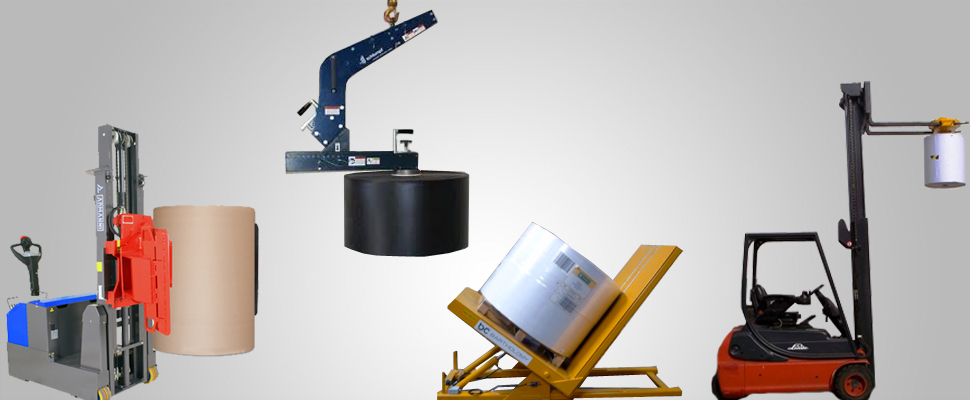Related: Roll Handling Solutions, Hoist Based Roll Handling and Potable Roll Handling
Roll handling is commonly defined as a method in which rolls of material are transported and oriented before and after web processing. Rolls of material are thin and flexible as they are often made of film, paper, foil or textiles and wound on a core made of metal, plastic or cardboard.
Items such as film, paper, foil and textiles are manufactured and wound on a core for further web processing or shipment to converters to be further processed. Rolls are often wound parallel to the floor, and generally, these rolls must be orientated perpendicular to the floor for the roll to be stored or shipped.
The purpose of roll handling is to transport wound rolls of material from one area to another. Two examples of this would be from the roll manufacturing process to storage or shipment areas and move rolls from the receiving department to the web processing equipment.
An example of a roll handling method would be the re-orientation of a roll of material from a horizontal position to perpendicular or vice versa. The proper use of roll handling equipment and methods are needed to ensure employees are kept safe and to minimize loss that are associated with roll damage.
Why is Roll Handling is Important to You
Many studies have been conducted about employee safety and how employers can reduce employee injury within the workplace. One of these studies was conducted by OSHA, they released their results in the ‘OSHA Fact Sheet NO.89-09’; this study found that back injuries are the nation’s #1 workplace safety problem.
This sheet further continued stating that preventing back injuries is a major workplace safety challenge, that over one million workers will suffer a back injury every year and that back injuries account for one of every five workplace injuries or illnesses! If that wasn’t enough to cause you to think about the importance of an ergonomic solution within a workplace then maybe this will; one-fourth of all compensation indemnity claims involve back injuries. This costs the industry billions of dollars on top of the pain and suffering these employees must face.
Employee safety is the most compelling reason for employers to invest in the proper utilization of roll handling methods and equipment. Secondary to this is roll damage and wasted material. If improper roll handling methods and equipment are in place, you could be throwing away thousands of dollars in damaged products.
Roll Handling Equipment
There are many types of roll handling equipment to choose from, all of which work slightly different and can be utilized for the unique task at hand. Below are some of the more common varieties of roll handling devices.
Truck Device Clamps:
Clamp trucks are a very common application for where extremely heavy rolls of material need to be handled. These roll handling devices use powered clamps that close on the outside of the material roll diameter.
Some advantages of this roll handling system include:
They can be designed to handle very heavy roll weights
They can move, turn and load rolls with one unit
They are easy to use
Many can handle multiple rolls at a time
These are mostly used in paper and board applications
Some disadvantages of this roll handing unit include:
Clamping on the outside of a roll may cause damage to the roll
Can easily damage foil and film rolls
Not well suited for small diameter rolls
Cause a limit of the use of the fork truck as it is not practical to change from a clamp to forks often
When handling multiple rolls, all of them must be the same diameter
Fork Truck Core Probe:
Another version of a truck roll handling device is the forklift core roll-handling probe, which can be inserted inside the core of a roll, allowing you to pick up the roll without causing any damage to the product. These devices are often used in lighter roll applications when outside damage to the roll is a concern.
These roll handling devices can be mounted to the mast of any standard forklift truck, and the core probe can pivot to orient the roll from a horizontal to a perpendicular position.
Advantages of a forklift truck with a rigid core probe:
Simple design, and easy to use
Able to handle multiple rolls with one probe
Roll diameters may be different for multiple roll handling
It can be designed to use remote or mounted controls
The probe can often be powered by electric, hydraulic or pneumatic actuation
It is well suited for smaller rolls
There is no roll sway when the roll is held in the air
The roll can be moved, turned, loaded and unloaded by one device
Disadvantages of this roll handling unit:
Not well suited for rolls weighing over 2,000 lbs
The probe to core alignment is a critical part of lifting the rolls which can at times be difficult to achieve because of the rigid probe mount
It may have problems gripping metal or plastic cores
The probe may damage the cores
Roll telescoping may be a problem with slippery webs or rolls wound loosely
Overhead Roll Handling Devices:
Overhead roll handling systems are very common and can be used in a variety of applications. Many of these systems will handle up to 2,000 lbs, and use core probes to grab the roll.
These roll handling devices are mainly designed to operate with hoists mounted overhead, they are often able to swivel to orient the rolls north to south, and the roll probes can be pivoted in orientation to move the roll to a horizontal or perpendicular position.
These roll handling devices can utilize either a single or dual hoist system. The main advantage of a dual hoist system is that it can position the roll in a truly horizontal or perpendicular position, helping to ensure that the rolls are never damaged when placing them on the floor, but a single hoist overhead roll handling system is a much more stable system. A single roll handling system will be able to operate with much less roll sway.
Some advantages of an overhead roll handling system include:
Commonly mechanically simple
They can handle multiple widths with only one probe
Often they can be designed with a remote pendant or mounted controls
They are well suited for rolls up to 2,000 lbs
They can orientate rolls effectively
There are many units, designs and styles to choose from
Disadvantages of an overhead roll handling system:
Not well suited for rolls that weigh over 2,000 lbs
They may have trouble gripping metal or plastic cores
The probe may damage the cores
A vacuum plate may be needed to combat roll telescoping
Roll positioning is limited to overhead placement
Walk-Behind Roll Handling Devices:
A walk-behind roll handling system is often used for light to medium roll weight applications. These systems can generally handle up to 1,000 lbs, however, there are some systems available that can handle up to 2,000 lbs. Walk-behind roll handling devices are self-contained, do not need any type of overhead equipment, and can pick up, turn, move, load and unload rolls.
Advantages of a walk-behind roll handling system
Able to handle rolls of multiple widths
Can be designed with manual or powered operation
It is well suited for rolls weighing up to 1,000 lbs
The core material is not an issue, as no damage to cores is possible
They can move, turn, load and unload rolls
Disadvantages of this Roll Handling System
Not well suited for rolls weighing over 1,000 lbs
Clamp roll handling systems may damage some types of materials
The roll diameters need to be the same for multiple roll applications
The powered units require a battery, which will need to be periodically recharged
Walk-Behind Roll Handling Unit with a Flexible Mount Core Probe
Advantages
Able to handle multiple widths with varying diameters
Can be designed with manual or powered operation
It is well suited for rolls up to 1,000 lbs
They can move, turn, load and unload rolls
No roll damage will occur to the outer layers
Disadvantages
Not well suited for rolls that weigh over 1,000 lbs
The core probe may have trouble gripping metal or plastic cores
The probe teeth may damage the cores
Roll may telescope
Powered units require a battery, and this will need to be recharged often
Tilt Table Devices:
A tilt table roll-handling device allows the user to turn roll 90 degrees. These tilt tables can be designed to handle loads up to 10,000 lbs and can be loaded with whole pallets of rolls to turn several rolls at one time.
Tilt Table Advantages:
Turn multiple rolls, or even whole pallets 90 degrees at one time
Avoid telescoping
Can turn very heavy loads
Tilt Table Disadvantages
Rolls must be brought to and from the tilt table
Turning rolls is a separate operation from moving the rolls
What You Should Consider When Searching for Roll Handling Equipment
There are many types and styles of roll handling equipment, each designed to complete a different task. Ask yourself the following questions before you start to look for a roll handling system. This will help you narrow down the search and make it easier to find the correct roll handling solution for your specific requirements.
How heavy are the rolls that need to be handled?
Do you wish to move rolls, run rolls or both?
What are the roll widths that you are handling?
What roll diameters do you want to handle? (Minimum to Maximum)
What is the roll core size(s)?
Are your cores made of cardboard, metal or plastic?
Are the outside layers of your material roll delicate?
Will damage to the core of the roll affect your operations?
How fast do you need to move rolls?
How fast do you need to turn the rolls?
Do you have an overhead material handling system in place? Or do you have the room for one?
Ensure that you have everyone involved in the decision process, and keep in mind their advice, because if the equipment operators are unable to use the equipment because they think it is to slow or cumbersome… they won’t use it!
When a roll handling solution is implemented properly within a business it will improve plant safety as well as the businesses’ bottom line. Ergonomic solutions reduce plant personnel injury and fatigue, as well as reducing waste that occurs due to roll damage. This, in turn, helps improve your process and increase your profits. With benefits like that, how can you not see the value from implementing a roll handling solution!
Do you know of other roll handling benefits? Share them in the comment section below!


